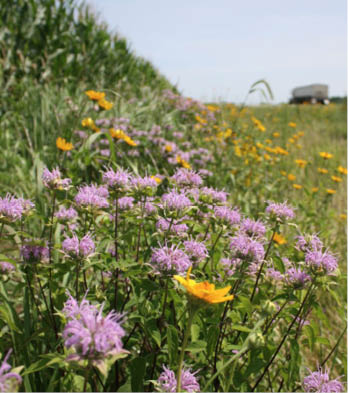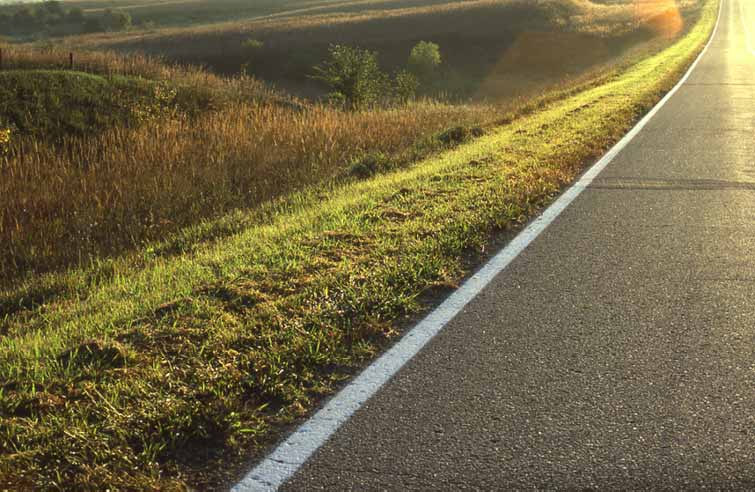ROADSIDE REVEGETATION
An Integrated Approach to Establishing Native Plants and Pollinator Habitat
8.1 I-35 Corridor (aka "The Monarch Highway") Case Studies
In 2014, President Obama released a Presidential Memorandum that tasked federal agencies with identifying strategies to promote the health of pollinators in order to reverse pollinator declines. The 2015 "National Strategy to Promote the Health of Honey Bees and Other Pollinators" was a direct outcome of the memorandum, and that strategy called for a multi-state partnership called the "Monarch Highway" along the I-35 corridor. Running through Minnesota, Iowa, Missouri, Kansas, Oklahoma, and Texas, the I-35 highway spans the central flyway monarch butterflies take during their annual migration. The "Monarch Highway" effort hopes to serve as a national model of cooperation to enhance pollinator habitat along transportation rights-of-way. The six states involved in the strategy have agreed to coordinate efforts to establish best practices and promote monarch butterfly and pollinator conservation. A list of I-35 plant species and their pollinator attributes is available in the Native Revegetation Resource Library.
The two following case studies highlight successful projects from Iowa, one of the six states that comprise the I-35 corridor where agencies are focused on restoring habitat to support the imperiled Monarch butterfly and other pollinators.
8.1.1 Bringing Prairie Back to Iowa: Iowa's Integrated Roadside Vegetation Management Program and Living Roadway Trust Fund

Butterfly milkweed and prairie coneflower flourish along an Iowa roadside.
Photo credit: Iowa Living Roadway Trust Fund
Prairie once dominated Iowa's landscape, covering more than 85 percent of the state. With less than 0.1 percent of virgin prairie remaining, and more than 95 percent of Iowa's original wetlands destroyed, Iowa has the nation's most altered landscape. Prior to the mid-1980s, roadside weed control in Iowa relied heavily on blanket spraying, putting large amounts of herbicide into the environment with undesirable consequences. Recognizing Iowa's lost heritage and the need to protect groundwater and surface waters, Iowa roadside managers began making some changes. For example, they began using native prairie grasses and wildflowers for erosion control and reintroduced "a little wildness," according to Kirk Henderson, retired State IRVM Specialist from the Native Roadside Vegetation Center at the University of Northern Iowa.
In 1989, the Iowa legislature passed IRVM legislation to promote an ecologically integrated approach to roadside management while maintaining a safe travel environment (Code of Iowa, Section 314). The legislation emphasized the establishment and protection of native vegetation as well as judicious use of herbicides, mowing, prescribed burning, and other management tools. Iowa is widely seen as a leader in IRVM, in large part because of this legislation. The bill also established the Living Roadway Trust Fund, an annual competitive grant program administered by the Iowa DOT that provides funding for school, city, county, and state projects, as well as research projects involving IRVM. Iowa's road use tax, along with several other sources, funds the Living Roadway Trust Fund. Roadside managers can submit applications to obtain resources to help implement IRVM, including vegetation inventories, purchasing native seed, equipment for burns or plant establishment, GPS units, signage, workshops, and more. Roadsides are seeded with mixes of species that are appropriate for a particular site, including many wildflowers that are attractive to pollinators. Seed mixes also contain species that bloom at different times throughout the growing season, which helps support pollinators all season long. The targeted vegetation management practiced by Iowa's roadside managers also benefits pollinators (Ries and others 2001).


Photo credit: Kirk Henderson
Research projects have also been supported by the Living Roadway Trust Fund, including studies of restoration techniques, as well as studies of the impact of roadside habitat on butterflies (Ries and others 2001) and bees (Hopwood and others 2010). Since the bill, more than 100,000 acres of Iowa's nearly 600,000 acres of state and county roadsides have been planted to native vegetation (Brandt and others 2015). In the process, Iowa has fostered the development of experienced roadside managers who are equipped to collaborate with other land managers around the state and bring habitat and wildlife, such as pollinators, back to Iowa's landscape.
8.1.2 Iowa's Natural Selections Program Increases Iowa Native Seed

Photo credit: Carl Kurtz
The Natural Selections program was formed to build the native seed industry in Iowa to meet the demands for high quality, regionally adapted, and genetically diverse sources of native seed for prairie restorations, including roadside restorations. For native regional seed to be priced to compete with cultivars, it has to be produced in commercial quantities. The Natural Selections program is a collaboration between state and federal agencies, as well as private corporations. Past or present partners include the Iowa Crop Improvement Association, the Living Roadway Trust Fund administered by Iowa DOT, USDA Natural Resources Conservation Service Elsberry Plant Materials Center, the University of Northern Iowa, and independent seed producers. Seed is collected by hand from remnant populations by the project manager and by volunteers throughout the state. Seed is collected from remnant roadsides, natural areas, and private land in three regional zones within Iowa. Iowa's Natural Selections program uses provenance zones large enough to support a market but narrow enough to retain regional distinctiveness. Collectors do not collect seed to intentionally select for certain traits. Foundation seed plots at the University of Northern Iowa amplify the seed, which is then further increased. Once seed has been increased, it is released to qualified native seed growers with production certified by the Iowa Crop Improvement Association. About 6 to 8 years after the initial collection, enough seed is available to sell to the public.
Successes of the project include increasing seed of 70 species, with nearly 120 ecotypes of 60 species released for commercial production and 180,000 to 200,000 pounds of ecotype source-identified seed produced annually. More information can be found at the Tall Prairie website.

